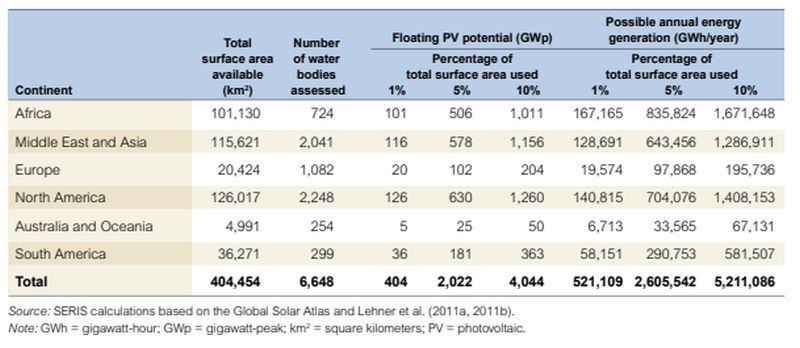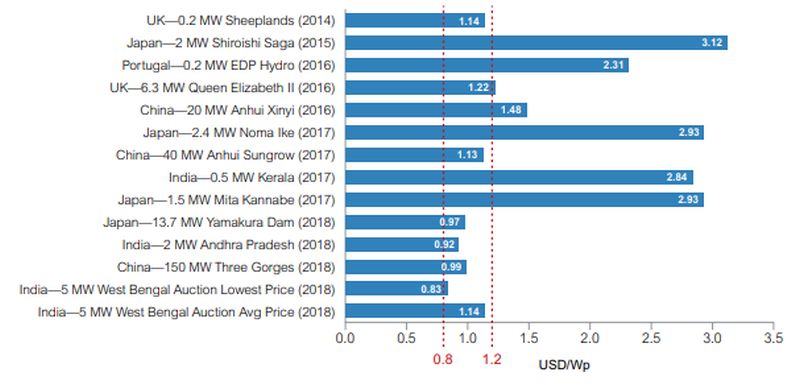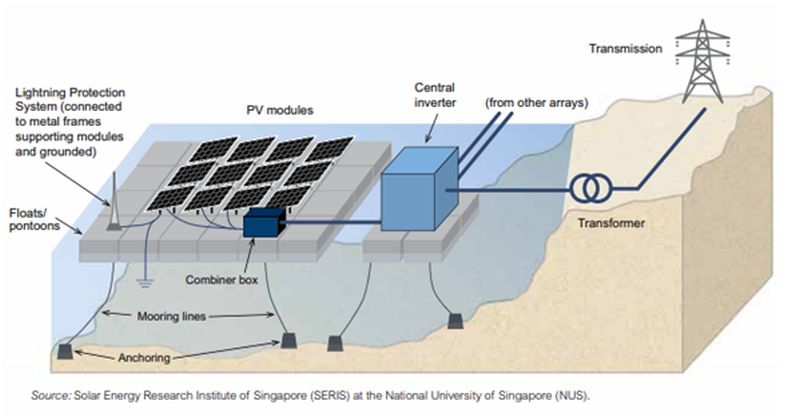A New Approach for Solar PV
As solar power installations continue to grow worldwide, the industry faces new challenges related to land scarcity and suitable roof availability for PV installations on commercial and large scale facilities. One of the best and new alternatives that are being considered as a valuable option for utility-scale and large commercial projects are the development of Floating Solar Power Plants, also called Floating Photovoltaic Plants (FPV).
Figure 1. Schematic of an FPV. Source: World Bank
FPVs are photovoltaic arrays similar to ground-mounting type installations, but with an important difference. In this case, the solar panels are fixed to a buoyant structure that allows them to float on water. The pontoon-type floating structure is anchored through mooring lines to the lake or sea bed underwater to keep the FPV steady within one sector.
The solar panels on these plants are fixed to a floating structure that resembles a flat ballasted type mounting system that keeps the modules stable on the water with a fixed-tilt. Combiner boxes, and in some cases power inverters, are also placed above floating structures close to the solar array to reduce DC and AC wiring losses of the FPV. This depends mainly on the proximity of the FPV to the shore and to the transmission or distribution line system. Figure 1 shows a schematic of the main components in an FPV
Why Floating Solar Power Plants?
 FPVs have an important advantage that makes them an attractive option for solar project developers and is related to land availability. As noted by David Trainavicius, Founder and CEO at PVCase, a design tool for utility-scale PV solar-parks: “Land acquisition for new Solar PV projects are becoming more complicated due to complex terrain. Floating Solar PV systems bring new opportunities to the market. With unused potential to use reservoirs water, we can expect FPV to grow up to 500GW globally.”
FPVs have an important advantage that makes them an attractive option for solar project developers and is related to land availability. As noted by David Trainavicius, Founder and CEO at PVCase, a design tool for utility-scale PV solar-parks: “Land acquisition for new Solar PV projects are becoming more complicated due to complex terrain. Floating Solar PV systems bring new opportunities to the market. With unused potential to use reservoirs water, we can expect FPV to grow up to 500GW globally.”
Large cities generally have few spaces available for the development of large scale utility plants, which makes it hard to design PV systems close to urban areas to increase efficiency and reduce transmission and distribution losses. Moreover, many times land-use must be debated between companies that may want to use it for livestock, crop fields, real-estate, or even for other wind, biomass, or fossil power plants.
However, as indicated by Trainavicius, FPVs are developed on the surface of lakes, irrigation ponds, industrial basins or drinking water reservoirs, where there is no competition with other companies. This also gives another usage to that amount of water square footage that can be used to generate power. Actually, FPVs can be developed in dams close to hydropower plants where installed transmission facilities can be used to reduce capital costs.
Hydro-connected PV plants have an increased reliability when compared to single source type power plants. Through a hybrid system implementation, the grid operator is able to balance hydro and solar energy generation throughout the day to complement both sources of energy. Meaning that between 11:00 am and 4:00 pm when solar energy has maximum energy yields, hydropower demand can be reduced. This is especially useful in drought seasons where water scarcity is a pressing matter or in the raining season comes when solar irradiance is low and hydropower can provide the missing power.
Moreover, FPVs have other important advantages that could leverage the decision to install a floating solar power plant as we can see below:
1. Single axis tracking:
FPVs can easily rotate on a single axis to follow the Sun’s position. This optimizes azimuth angle tracking and is able to increase energy yields.
2. Zero near-shading losses:
Since FPVs are located on large water reservoirs, there are no nearby objects such as buildings or trees that could cause shading losses in the PV array. This eliminates one of the most important loss factors in PV systems and only leaves room for far-shading losses which are minimum.
3. No dust accumulation:
Water bodies tend to have few to zero sources of dust. Unlike ground-mounted systems installed in desert locations, FPVs would not suffer soiling losses due to dust.
4. Reduced water consumption and maintenance costs:
One of the most demanding operational and maintenance (O&M) costs is related to cleaning. By using water from the lake to clean the solar panels there is no cost associated with obtaining water to clean the modules. Moreover, it is environmentally friendly, since water is recycled inside the same reservoir.
5. Reduced algae formation:
Since less sunlight reaches the water body, algae formation is drastically reduced. This is positive for water utility companies as water treatment costs are also reduced.
6. Reduced evaporation losses:
Besides producing power, FPVs can also have an important effect on water conservation. Studies have found that evaporation losses can be reduced by 70%. This represents a very important advantage that allows water utility companies and hydropower facilities to deal with water scarcity during the summer season.
7. Reduction in thermal losses:
The cooling effect of water being close to the modules implies that the solar panels will have a lower operating temperature that will increase the energy yields of the PV array. Studies have found that up to an additional 10% of energy yields can be obtained when compared to land-based PV systems thanks to operating temperature reduction.
Finally, comprising all of these advantages, experiences and studies have found that when comparing FPVs to land-based installations, up to 20% more energy yields can be obtained [1].
The Market Opportunity
According to a report from the World Bank, there are over 400,000 km2 of man-made reservoirs in the world. Making a conservative estimation, the potential market potential for this technology can go from 400 GW worldwide (which is the current total installed capacity in solar power) if using 1% of these water reservoirs, to 4 TW worldwide if using 10%.
 Figure 2. FPV market potential estimation. Source: World Bank
Figure 2. FPV market potential estimation. Source: World Bank
Currently, the largest market players in this sector are located in Asia. China is the first with the largest FPV installed worldwide, followed by India, Japan, and Singapore.
Also, the capital investment costs of this technology are slightly higher or even comparable with ground-mounted installations in some sites. Costs increase mainly due to the cost of floats, resilient materials (resistant to water), moorings and anchors. However, according to the same World Bank report as of 2018, costs associated with FPV in these regions typically vary between 0.8-1.2 $/W which is comparable with utility-scale PV single-axis tracking power plant costs in the US which by 2018 cost around 1.13 $/W according to NREL.
 Figure 3. FPV costs worldwide between 2014-2018. Source: World Bank
Figure 3. FPV costs worldwide between 2014-2018. Source: World Bank
Market Innovation
As you can see, the possibilities of expansion in this market are promising. Actually, when comparing FPV worldwide installed capacity in 2016 (132 MW) to September’s 2018 installed capacity (1.09 GW), you will realize that over 900 MW in new installed capacity were deployed, representing a growth of nearly 800% in only 2 years.
New technologies like these will need new software applications that allow integration and maneuverability with customizable design options for the floating buoyant and support structures on the water surface.
Article Submitted By Community Writer



